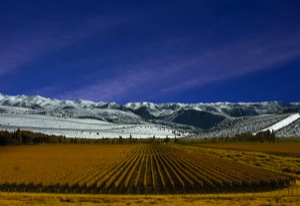
Argentina, the fifth largest wine producing country in the world, typically begins its harvest the first weekend in February. The famed wine harvest festival Vendimia actually begins in January in various locations around the country and then zeroes in on the city of Mendoza. Like many other celebrated wine festivals, these celebrations include religious ceremonies to bless the grapes, sporting events and a lot of wine and merriment on into April. The infamous crowning of the Reina Nacional de la Vendimia also takes place during this time.
Every year the Instituto Nacional de Vitivinicultura (INV), the main government body controlling the wine industry, declares the start date for harvest in a region. Sometimes the harvest season will last all the way through April. What makes Argentina’s harvest more interesting is that exactly when it starts depends on a number of factors. There are systems used in the vineyard, such as high trellises or hail protection that may slow ripening.
Certain climate conditions play a huge factor, and some years growers that may be fearful of late summer hailstorms, will rush their harvest in earlier than would otherwise be ideal. Though there is one rule that holds very true every year: Once the harvest starts, all grapes need to be in within six to eight weeks. A daunting task especially when you consider the different amounts of varietals grown.
Malbec is probably the most known grape to be grown in Argentina. It is a difficult grape to grow but due to Argentina’s warm climate and conditions, the grape does very well. Over the years the country has seen outside influences. The French brought Malbec vines, but also Syrah. The Italians brought vines that they called Bonarda, but also planted their famed Sangoviese. These days the traditional grapes of Cabernet Sauvignon, Merlot, and Chardonnay are being more widely planted.
While white grapes are grown, Torrontés and Chardonnay in particular, Argentina predominantly is a red wine-producing nation. The hot and dry climate is simply better suited to red grapes, although this may not be the case in the future. Growers are looking increasingly further south for good grape-growing land.
Argentina’s wine industry certainly has made a remarkable impact over the last several years. It was really around the ‘90s that the wine world started to see some amazing exports. Up until that time, wines exported were of low quality and mass produced. Some wines are produced specifically to be exported to America and Europe. There are now more than 1,500 wineries in the country and production is at an all-time high.
It is true, however, that Argentina’s best wines are kept in the country. Unfair as it may be, it should just be another reason to take a trip down there.
But I do urge you to try some of the Argentinian wines that are on our shelves. A few tips for buying: Look for single varietal wines; they will be the best quality. It is a law that if a grape is listed on the bottle, 80 percent must be that varietal. This allows you to really taste the grape and the winemaker’s craft.
As another year passes and the 2012 harvest begins, look forward to another great year of wine from Argentina. Head over to your favorite wine store, and pick up a few bottles. And don’t just choose the ever so popular Malbec. Try a white or a grape you never heard of. You will thank me in the end.










